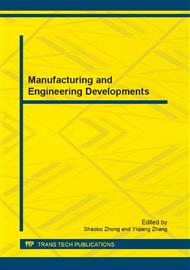[1]
R. A. Myers, N. Mukherjee and S. R. J (1991) Brubeck, Large second-order nonlinearity in poled fused silica. Opt. Let 1(22): 1732-1734.
DOI: 10.1364/ol.16.001732
Google Scholar
[2]
N. Mukherjee, R. A. Myers, and S. R. J (1994) Brubeck, Dynamics of second-harmonic generation in fused silica . Opt. Soc. Am, , B11: 665 2(8): 112-115.
Google Scholar
[3]
T. G. Alley, S. R. J. Brubeck, R. A (1998) Myers, Space -charge dynamics in thermally poled fused silica. J Non-Crypt State 3(12): 165-176.
DOI: 10.1016/s0022-3093(98)00788-1
Google Scholar
[4]
Yitao Ren,. Zhengquan Dai and Jian Wang (2012) Theoretical Analysis of the Depletion Layer's Distribution in Thermally-poled Silica . Journal of the Korean Physical Society 4(8): 241-245.
DOI: 10.3938/jkps.60.1224
Google Scholar
[5]
Xueming Liu, Mingde Zhang, Xiao han Sun (2000) Model for thermal/electric-field poling of fused silica . ACTA Physical Sinica 5(3): 538-543.
Google Scholar
[6]
M. Dussauze and V. Rodriguez, A (2010) Lipovskii and M Petron, How Does Thermal Poling Affect the Structure of Soda-lime Glass. J. Phys. Chem. C. 6(7): 12754-12759.
DOI: 10.1021/jp1033905
Google Scholar
[7]
T. G. Alley, S. R. J (1998) Brubeck, Visualization of the nonlinear optical space-charge region of bulk thermally poled fused-silica glass . Opt. Letts 7(15): 1170-1172.
DOI: 10.1364/ol.23.001170
Google Scholar
[8]
P. G . Kazan sky, A. R . Smith, P. S . J . Russell et al (1996) Thermally poled silica glass: Laser induced pressure pulse probe of charge distribution . Apple, Phys Letts 8(7): 269-273.
DOI: 10.1063/1.115659
Google Scholar
[9]
P. G. Kazan sky, A. Kamala and P. St. J (1993) Russell, Erasure of thermally poled second-order nonlinearity in fuse silica by electron implantation . Opt. Letts 9(14): 1141-1143.
DOI: 10.1364/ol.18.001141
Google Scholar
[10]
R. Kashyap, G. J. Veldhuis, D. C. Rogers and P. E McKee (1994) Phase-matched second-harmonic generation by periodic poling of fused silica . Appl. Phys. Letts 10(11): 1332-1334.
DOI: 10.1063/1.111925
Google Scholar
[11]
L. C. Triques. C. M. B. Cord eirio. And V. Bales Trier (2000) Depletion region in thermally poled fused silica . Appl. Phys. Letts 11(18): 2496-2498.
DOI: 10.1063/1.126387
Google Scholar
[12]
P. Xesus and L. Jesus (1996) Increasing resistivity effects in field-assisted ion exchange for planar optical waveguide . Optics Letters 12(21): 1363-1365.
DOI: 10.1364/ol.21.001363
Google Scholar
[13]
Kolinsky, Y. Qui quempois and G. Marginally (2005) Modeling of the susceptibility time -evolution in thermally poled fused silica. Optics express 13(20): 8015-8024.
DOI: 10.1364/opex.13.008015
Google Scholar
[14]
Yao Liu, Ruohe Yao (2005) The built-in electric field is analyzed by proliferation of p-n junction . Physic of Guangxi 14(1): 16-21.
Google Scholar
[15]
Xueming Liu, Xiaoping Zhen, Yili Guo, et al (2002) Theoretical analysis For Fused Silica After.
Google Scholar
[16]
Thermal/Electric-field poling . Science China (Series E) 15(5): 251-255.
Google Scholar
[17]
D Purenr, A C Liu, M J F Dignity, et al (1998) Absolute measurement of the second-order nonlinearity profile in poled silica. Opt Letts 16(8): 588-591.
Google Scholar
[18]
V Pruner, F Smoggier, G Conflate, et al (2000) Thermal poling of silica in air and under vacuum: the influence of charge transport on second harmonic generation . Apple Phys 17(8): 4881-4883.
Google Scholar


